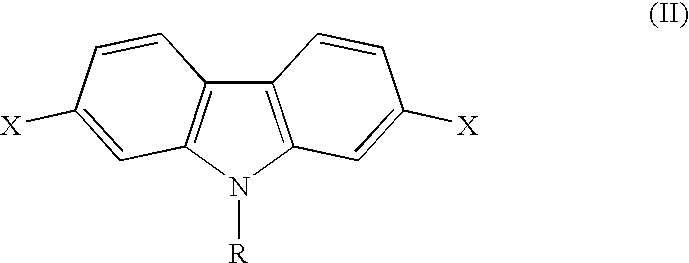Conjugated polycarbazole derivatives and process for the preparation thereof
a technology of conjugated polycarbazole and derivatives, applied in the field of conjugated polycarbazole derivatives, can solve the problems of not optimizing the development of light-emitting diodes, electrochromic windows, photorefractive materials, etc., and achieve the effect of improving optical and electrochemical properties
- Summary
- Abstract
- Description
- Claims
- Application Information
AI Technical Summary
Benefits of technology
Problems solved by technology
Method used
Image
Examples
example 1
Preparation of poly(N-octyl-2,7-carbazole)
[0014] Following the procedure developed by Smith and Brown and reported in J. Am. Chem. Soc., Vol. 73, p. 2438 (1951), 4,4'-dinitro-2-biphenylami-ne (Aldrich Co.) was treated with NaNO.sub.2 and NaN.sub.3 to give the corresponding azide via the transformation of the amino group into a diazonium salt. A ring closure reaction, assured by a nitrene intermediate, was carried out to give 2,7-dinitrocarbazole in a 66% yield. This compound was then reduced using SnCl.sub.2 in a mixture of acetic acid / HCl (5:1) to give 2,7-diaminocarbazole in a 78% yield. Then, the amino groups of the resulting product were transformed to iodine atoms; the reaction was carried out in a 3M HCI solution using NaNO.sub.2 and KI. N-octyl-2,7-diiodocarbazole was prepared in a 93% yield from 2,7-diiodocarbazole upon reaction with K.sub.2CO.sub.3 and 1-bromooctane in anhydrous DMF at 80.degree. C. All monomers were characterized by NMR and mass spectrometry. Homopolymeriz...
example 2
Preparation of poly(N-octyl-2,7-carbazole-alt-9,9-dioctyl-2,7-fluorene) and poly[N-(2-ethylhexyl)-2,7-carbazole-alt-5,5'-(2,2'-bithiophene)]
[0017] Alternating copolymers were prepared from Suzuki couplings (described by Ranger, M. et al. in Macromolecules, Vol. 30, p. 768 (1997)) between di-boronic functionalized aromatic units and N-alkyl-2,7-diiodocarbazole derivatives. Poly(N-octyl-2,7-carbazole-alt-9-,9-dioctyl-2,7-fluorene) was prepared from a reaction between 2,7-bis(4,4,5,5-tetramethyl-1,3,2-dioxaborolan-2yl)-9,9-dioctylfluorene and N-octyl-2,7-diiodocarbazole using (PPh.sub.3).sub.4Pd(0) as catalyst in a mixture of THF and 2 M K.sub.2CO.sub.3 aqueous solution. Moreover, Stille couplings (described by Yu, L. et al. in Acc. Chem. Res., Vol. 29, p. 13 (1996)) between distannyl aromatic derivatives and N-alkyl-2,7-diiodocarbazole derivatives are possible. As an example, poly[N-(2-ethylhexyl)-2,7-carbazole-alt-5,5'-(2,2'-bithiophene)] was obtained with a good yield from N-(2-ethy...
example 3
Preparation of poly (N-octyl-2,7-carbazole)
[0018] In order to obtain a reactive monomer in better global yield than obtained with 2,7-diiodocarbazole derivatives, N-octyl-2,7-bis(trifluorom-ethanesulfonyl)carbazole was synthesized as follows: 8
[0019] The biphenyl unit (11) was obtained using a Suzuki coupling between 4-methoxyphenylboronic acid and 4-bromo-3-nitroanisole in standard conditions. Then, a Cadogan ring closure reaction was carried out in hot triethylphosphite to give 2,7-dimethoxycarbazole (12) as reported in Macromolecules, Vol. 18, p. 1388 (1985). This compound was alkylated using finely powdered NaOH, phase transfer agent and primary alkyl bromide in anhydrous acetone. From compound (13), a standard deprotection reaction using BBr.sub.3 in methylene chloride was achieved to give 2,7-dihydroxycarbazole (14), in relatively good yields. Finally, monomer (14) was treated with DMAP and trifluoromethanesulfonic anhydride in cold pyridine to give monomers (15) that can unde...
PUM
| Property | Measurement | Unit |
|---|---|---|
| temperature | aaaaa | aaaaa |
| temperature | aaaaa | aaaaa |
| number-average molecular weight | aaaaa | aaaaa |
Abstract
Description
Claims
Application Information
 Login to View More
Login to View More - Generate Ideas
- Intellectual Property
- Life Sciences
- Materials
- Tech Scout
- Unparalleled Data Quality
- Higher Quality Content
- 60% Fewer Hallucinations
Browse by: Latest US Patents, China's latest patents, Technical Efficacy Thesaurus, Application Domain, Technology Topic, Popular Technical Reports.
© 2025 PatSnap. All rights reserved.Legal|Privacy policy|Modern Slavery Act Transparency Statement|Sitemap|About US| Contact US: help@patsnap.com



